So who knew gardening was such a controversial activity? Your local county extension does, for one. And your state agriculture watchdogs do. I won’t go so far as to say they see you when you’re sleeping, they know when you’re awake… but when you live in New York, you can never be too sure. Hopefully your state is a little more chill than mine, but just in case, this post summarizes what’s commonly illegal in terms of fruit gardening (and why!).
And for today, I’ve got a rundown on a couple of historically “most wanted” banned fruit plants for northern gardeners. Am I an expert? No way. But do I wish I knew this stuff when I first started combing through seed catalogs? You bet. As they say about the best-laid plans of mice and men, sometimes the best-laid plans for fruit gardening world domination are waylaid by a little something called legality.
Ladies and gentlemen, meet the bad boys of the fruit gardening world.
BANNED SOFT FRUIT: CURRANTS
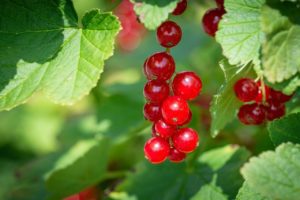 Currants — white, red, pink and black — are exceptionally high on the commonly-banned list (at least, they’re the ones that I hear the most about). Because they are a Ribes genus plant, these lovely little fruit plants were banned on the federal level for 55 years, and not only was it illegal to grow them in every state, but there was also an eradication program focused on wiping them out.
Currants — white, red, pink and black — are exceptionally high on the commonly-banned list (at least, they’re the ones that I hear the most about). Because they are a Ribes genus plant, these lovely little fruit plants were banned on the federal level for 55 years, and not only was it illegal to grow them in every state, but there was also an eradication program focused on wiping them out.
Currants — white, red, pink and black — are exceptionally high on the commonly-banned list (at least, they’re the ones that I hear the most about). Because they are a Ribes genus plant, these lovely little fruit plants were banned on the federal level for 55 years, and not only was it illegal to grow them in every state, but there was also an eradication program focused on wiping them out.
And what, you ask, caused this mass outrage?
Good question. The reasoning behind the ban was the Ribes’ species’ tendency to host a nasty little disease called white pine blister rust. This disease — you guessed it — is a major problem for white pine trees. The thought was that by eliminating alternate hosts, the disease could be controlled.
The thing is, there doesn’t seem to be a clear consensus on whether or not currants are actually that big of a deal in terms of hosting the disease. Oh sure, there’s no question that they do — but look anywhere and you can find that they aren’t the only hosts (random example — it took me two seconds to find this article on Ribes from the University of Maryland Extension). There’s real question about whether eliminating ONE alternative host for the disease is really going to do much.
The federal ban was rescinded in 1966, but don’t applaud too quickly. Once the national rule goes, that still leaves state and local players in the mix. There’s a large group of states that have banned the fruit either in the past or currently (OK, I know that’s terrible grammar, but you know I had to fit that magnificent pun in here somewhere, right?). On top of THAT, you may find that your local township has a regulation on the books that disallows growing these fruits.
**As a quick FYI, according to that article from UMD Extension, check into red and white currants; they’re less likely to be a host to nasty diseases than (most) black currants, although you can find disease-resistant black cultivars too.**
BANNED SOFT FRUIT: GOOSEBERRIES
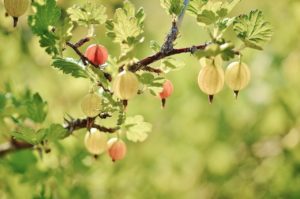 Gooseberry plants! Green or pinky purple, these odd little fruits are an old-fashioned staple but can be tough to find in local nurseries or in the wild. Whatever happened to these soft fruits?
Gooseberry plants! Green or pinky purple, these odd little fruits are an old-fashioned staple but can be tough to find in local nurseries or in the wild. Whatever happened to these soft fruits?
Gooseberry plants! Green or pinky purple, these odd little fruits are an old-fashioned staple but can be tough to find in local nurseries or in the wild. Whatever happened to these soft fruits?
Well, you may sense a theme here. Gooseberries are also in the Ribes family, and they were banned for the same reason currants were: suspicion of fraternizing with humans white pine blister rust. They were subject to the same federal ban from 1911 to 1966, and were “freed” by the same ban rescindment — but once again, states and local government can and do ban this fruit if they believe it threatens local fauna.
Plus, those many years of banishment didn’t do much for the plant’s popularity; although once upon a time it was ever-present, it has really struggled to win back its old-timey popularity. (I mean honestly. When I think gooseberries, it doesn’t strike me as edible any more than cowslips or cattails do.). These plants have a definite PR problem going on.
The good news is that gooseberries are significantly less likely than currants to act as a host for the white pine blister rust, meaning that your state and local laws may be more permissive than they would for something like a black currant. HOWEVER, just to be on the safe side, you should be careful planting this fruit if your area has white pines; you can’t be too careful, right?
BANNED FRUIT TREE: MULBERRIES
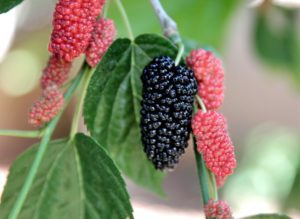 I’m very new to the world of mulberries. Although certain varieties do thrive in my northern climate, I’ve focused most of my gardening efforts on other fruit trees and plants, as well as growing tropical fruits and spices on my windowsill. I was certainly aware of the mulberry, but it just didn’t sound exciting.
I’m very new to the world of mulberries. Although certain varieties do thrive in my northern climate, I’ve focused most of my gardening efforts on other fruit trees and plants, as well as growing tropical fruits and spices on my windowsill. I was certainly aware of the mulberry, but it just didn’t sound exciting.
However, once I put in a little research, I was fascinated. The amount of fruit these trees put out is just phenomenal, the amount of care needed is minimal, and it does have a unique status in the fruit garden, because how many other full-size trees can you find that produce soft fruit?
Sure, growing a mulberry tree can be messy when the fruit is in season and starts dropping everywhere, but if you plant it by a chicken yard (yes, I do have chickens that would like to be a bit more free-range than I allow), they take care of that problem for you. As a fruit tree, the mulberry is a bit of a unicorn, and I admit it – I’m hooked.
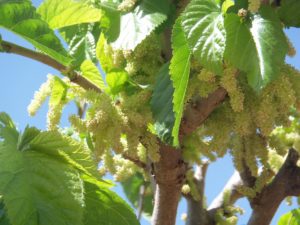 So why did the mulberry come under fire?
So why did the mulberry come under fire?
When I saw that it had been banned in some areas, my first thought was that it must be because the tree is just an old-fashioned nuisance. After all, it does drop berries EVERYWHERE, and if it overhangs a sidewalk, that means those berries get tracked everywhere, leaving splotchy little stains that would drive me crazy. In a public or urban environment, I get it; that’s annoying.
However, that’s not why the mulberry was banned. The tree has come under intense fire because it is an absolute fountain of pollen, and it can be a literal headache for those with seasonal allergies.
Particularly in cities, where the airflow tends to be a bit stagnated, the impact of these waves of irritants has been, well, irritating enough that legislators have taken action – and the mulberry has landed on the banned list.
BANNED FRUIT TREE: OLIVES
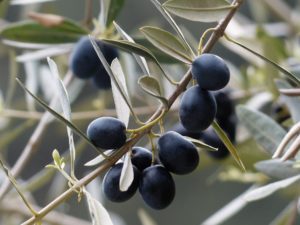 I’ll be honest, the mulberries didn’t surprise me, but this entry did. Olives? Doesn’t everybody everywhere love olives? Olive oil is soooooo popular, much healthier than the alternatives, and it tastes pretty darn good, too. On top of that, the tree is insanely drought-tolerant, thrives in lousy soil, and makes a visually stunning addition to the landscape.
I’ll be honest, the mulberries didn’t surprise me, but this entry did. Olives? Doesn’t everybody everywhere love olives? Olive oil is soooooo popular, much healthier than the alternatives, and it tastes pretty darn good, too. On top of that, the tree is insanely drought-tolerant, thrives in lousy soil, and makes a visually stunning addition to the landscape.
(Yes, yes I know, processing olives is a pain and a half, and improperly curing the olives will make you sick as a dog… but still, to grow olive trees in containers on my windowsill has always been a pet project of mine.)
However, the olive has come under fire for exactly the same reason as the mulberry. In warm, dry climates where the tree is a common ornamental, its impact during allergy season is considered downright noxious.
In Pima County, Arizona, the purchase or sale of the olive tree is banned, and you can’t even plant one that was given you as a gift – the tree is considered a nuisance, and if the authorities discover one on your property, you are required to dispose of it immediately (well, within 24 hours).
Pima County isn’t the only locality with a ban, either. Apparently, the pollen-spewing qualities of the olive are well known, and other cities and counties have implemented their own bans (most commonly, I see bans referenced for other Arizona communities, as well as Nevada). Interestingly, though, some of these bans allow for exceptions for certain varieties of fruit-producing trees, so if you’re in one of these communities, you may possibly get away with planting an olive tree yet.
NORTHERN GARDENERS AND OUTLAWED FRUITS
The good news about pollen-specific tree bans, such as the mulberry and the olive, is that they are typically very localized – instead of banning gardeners from growing these fruit trees anywhere in the country (like bans on growing currant and gooseberry plants have done) most locations in the United States do allow you to grow mulberries and olives.
Further, most northern gardeners will not have to worry about olive tree bans any time soon. Because tender species such as the olive cannot survive in winter weather, they rarely catch the eye of local legislators. One potted tree has a negligible impact on the pollen load of a northern climate, so your windowsill garden is safe.
Mulberries? Well, I make no promises there; some varieties are hardy to zone 4, which means that they are more common in northern areas. However, their popularity still ranks so far below other pollen-producing trees that I don’t expect any bans in my vicinity any time soon. For colder hardiness zones, these banned fruit trees – the mulberry and the olive – appear to have found a safe haven, but always keep your eye out for trees getting added to the outlaw list!
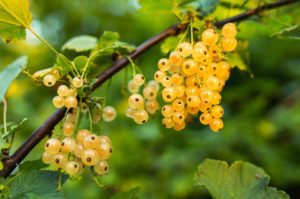 Will your garden supply company give you a warning if you try to buy a banned fruit that’s illegal for your area? Maybe, but don’t count on it.
Will your garden supply company give you a warning if you try to buy a banned fruit that’s illegal for your area? Maybe, but don’t count on it.
Online nurseries may provide little notices at the bottom of a product description (“Cannot ship to NY, NH, VT, etc…”), but you can’t assume that those restrictions are comprehensive. There’s no garden supply company on earth that has time to comb through every county of every state’s ag-regulations handbook.
Moral of the story here? Reach out to your county extension agent and find out what’s legal before you buy. I’m not going to get into the argument of whether or not the bans are a good thing or a misinformed decision — but the fact remains that the bans are still legal bans. You don’t want to trip over regulations that you didn’t even know existed.
This post was originally published in 2021. The post has since been updated to keep information and links current.